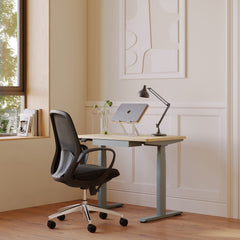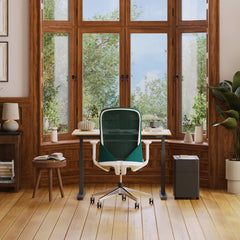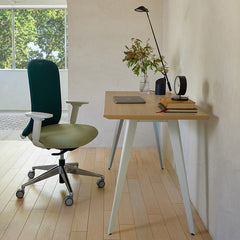Get 10% off your first order
Find the office furniture that’s designed to match your style, comfort, and needs perfectly. Subscribe
Space Shift: The Art of the Live-Work Fusion

Visit quiz page to see how we makes it easy to create an inspiring workplace


The choices we make when furnishing our homes have a lasting impact, not only on our comfort but on the planet. The concept of "low-waste furniture" moves beyond recycling and focuses on mindful consumption: choosing durable materials, prioritizing longevity, and supporting ethical production. It is about creating a beautiful space that aligns with your values, ensuring that your furniture is built to last for generations, not years.
Designing a space with the planet in mind means rejecting the cycle of fast furniture. When you invest in high-quality, sustainable pieces, you reduce the demand for disposable goods and the environmental strain of frequent replacement. This shift toward responsible design leads to a home that feels more authentic, stable, and truly yours.
The most effective way to be low-waste is to choose quality pieces that you will never need to throw away. Sustainability is baked into the design through robust construction, timeless aesthetics, and the use of responsibly sourced materials. This focus on permanence means that the furniture itself is an investment in both your home and the environment.
This commitment to quality is crucial even for highly functional pieces. A height-adjustable standing desk, for example, is a sustainable choice when it is built with durable components that ensure it will function reliably for many years, eliminating the need for replacement.
The journey to a low-waste home starts with understanding the materials used in your furniture. Not all materials are created equal in terms of environmental impact, durability, and eventual biodegradability or recyclability.
Look for furniture crafted from materials that minimize ecological damage. This includes sustainable wood, recycled metals, and natural fibers with minimal chemical processing.
Sustainably Sourced Wood: Look for certifications that guarantee the wood comes from responsibly managed forests.
Recycled Metal: Aluminum and steel are highly recyclable and their use significantly reduces the energy required for virgin material production.
Non-Toxic Finishes: Furniture should be finished with low-VOC (Volatile Organic Compounds) stains and sealants to ensure healthy indoor air quality.
The single greatest low-waste decision you can make is choosing furniture that is built to last. A piece that lasts 30 years instead of 3 years is inherently more sustainable, regardless of its original materials.
Durability is not just about weight; it is about construction techniques, joint stability, and the integrity of the materials. Avoid pieces made with cheap fasteners or low-density particle board.
Durability Indicators (Checklist):
☐ Solid Joinery: Look for traditional joinery methods like dovetail joints or mortise and tenon, not just glue and staples.
☐ Heavy Gauge Metal: If the piece has a metal frame, the metal should feel substantial and show precise, strong welds.
☐ Hardware Quality: Ensure all drawer slides, hinges, and moving parts are heavy-duty and rated for thousands of cycles.
☐ Surface Density: If choosing a composite wood top, ensure it is high-density and resistant to chipping and moisture.
Furniture that follows fleeting trends is more likely to be discarded when those trends fade. Low-waste design favors timeless, versatile aesthetics that can adapt to evolving personal tastes and décor styles.
Choosing pieces with clean, classic lines and neutral color palettes ensures they will remain relevant. This adaptability means you can change the room's entire feel simply by swapping accessories, art, or textiles, leaving the core furniture intact.
For instance, a simple, elegant modern office desk with high-quality wood and metal construction will look just as relevant a decade from now as it does today, providing a sustainable foundation for your workspace.
Low-waste furniture is often modular or highly adjustable, allowing it to serve multiple functions or be easily relocated and reconfigured. This flexibility extends the life of the piece as your needs change.
Adaptable furniture is critical for the low-waste home, especially in smaller apartments or multi-purpose rooms. It means the piece remains useful even if you move or repurpose the space.
For small or non-dedicated home offices, furniture must be particularly resourceful. A piece like the Small Standing Desk Nevada is a sustainable choice because its compact, adjustable design ensures it remains functional and valuable, even if it has to move into a tiny corner or be used for another purpose later. Its long-term utility makes it inherently low-waste.

The concept of "fast furniture" mirrors "fast fashion": cheap, disposable items that quickly end up in landfills. Actively boycotting this cycle is the most significant step toward low-waste furnishing.
While the initial price tag is low, fast furniture quickly deteriorates, forcing repeat purchases. The environmental cost of its production, transportation, and landfill disposal far outweighs the small savings. Investing in one durable piece saves money and resources in the long run.
The Fast Furniture Trap (Table):
|
Factor |
Fast Furniture |
Low-Waste Furniture |
Environmental Impact |
|
Lifespan |
1-5 Years |
15-30+ Years |
Significant reduction in landfill waste. |
|
Materials |
Particleboard, thin veneer |
Solid wood, recycled metal |
Reduction of virgin resource extraction. |
|
Toxicity |
High VOCs |
Low-VOC finishes |
Healthier indoor air quality. |
Choosing ergonomic furniture is also a low-waste decision, as it prevents the physical deterioration that often causes workers to seek a replacement setup. A healthy setup is one you can use comfortably for years.
A chair or desk that is poorly designed for your body will eventually cause pain, forcing you to dispose of it and buy a new one in search of comfort. Ergonomic quality ensures functional longevity.
This connection is clear in the choice of supportive seating. A properly designed chair should meet extensive safety standards. Research into ergonomic requirements for a comfortable and healthy workspace, such such as guidelines on ergonomic chairs, emphasizes that a chair must be highly adjustable to be used by the same person over a long career.
Low-waste furniture is designed to be repaired, refinished, and restored, not replaced. Look for wood pieces that can be sanded and re-stained, and metal frames that can be disassembled for simple component replacement.
The concept of Design for Disassembly ensures that pieces can be easily taken apart at the end of their life for efficient recycling of materials. This is a hallmark of truly responsible manufacturing.
Restoration Factors (Enumeration):
Exposed Fasteners: Screws and bolts should be visible and accessible, not hidden or glued.
Simple Finish: Avoid finishes that require specialized industrial processes for repair; natural oils and waxes are easy to refinish at home.
Standardized Parts: Quality manufacturers often use standard hardware that can be replaced easily if damaged.
The commitment to sustainability should extend beyond major furniture items to accessories and workspace tools. These smaller items contribute to visual clutter and waste if they are not chosen carefully.
When choosing peripherals, prioritize durability and function. For example, selecting an adjustable metal tool like an ergonomic monitor arm is a low-waste choice because it is built to last and ensures optimal screen positioning, preventing the need for temporary, disposable screen risers or stands.
Rechargeable Devices: Choose rechargeable battery-powered accessories to reduce battery waste.
Natural Materials: Opt for accessories made from bamboo, cork, or recycled rubber.
Minimal Packaging: Choose products with minimal, recyclable packaging.
In a low-waste home, every item serves a distinct purpose, reducing the need for excessive storage furniture. Effective space planning minimizes clutter and maximizes the utility of each piece.
Visual clutter often leads to psychological stress, which can pressure the homeowner to discard items or buy new, often unnecessary, storage solutions. A minimalist approach is inherently low-waste.
Space Planning for Zero-Waste (Table):
|
Goal |
Strategy |
Low-Waste Outcome |
|
Maximize Storage |
Use vertical wall shelving and closed cabinets. |
Reduces the need for multiple floor-standing units. |
|
Maintain Visibility |
Only keep essential items in sight on your desktop. |
Minimizes visual stress; reinforces intentionality. |
|
Define Zones |
Use rugs or shelving to define a dedicated workspace. |
Ensures furniture is used for its specific, intended purpose. |
Ultimately, low-waste design relies on the user's commitment to care and intentionality. Treating your furniture as a long-term investment ensures its longevity and maximizes its positive environmental impact.
Take pride in maintaining your quality pieces. Regular cleaning, occasional oiling of wood, and promptly addressing minor issues prevent small problems from becoming irreversible damage. This personal responsibility is the final, crucial step in low-waste living.
The decision to choose low-waste, durable furniture is a commitment to a larger environmental vision. It allows you to build a comfortable, beautiful home that tells a story of responsibility and longevity, ensuring that your space is truly sustainable from the ground up.

Designing a low-waste space is not a sacrifice; it is an upgrade. It transforms your home into a collection of durable, beautiful pieces that carry a positive story—a testament to quality over quantity. By prioritizing timeless design, repairable materials, and functional longevity, you create a space that not only nourishes your well-being but also leaves a lighter footprint on the planet. Choose wisely today to build a sustainable legacy for tomorrow.

Space Shift: The Art of the Live-Work Fusion

How to Arrange Furniture to Maximize Peace

Crafting Calm: Your Guide to the Perfect Reading Corner
Get 10% off your first order
Find the office furniture that’s designed to match your style, comfort, and needs perfectly. Subscribe
Leave a comment